
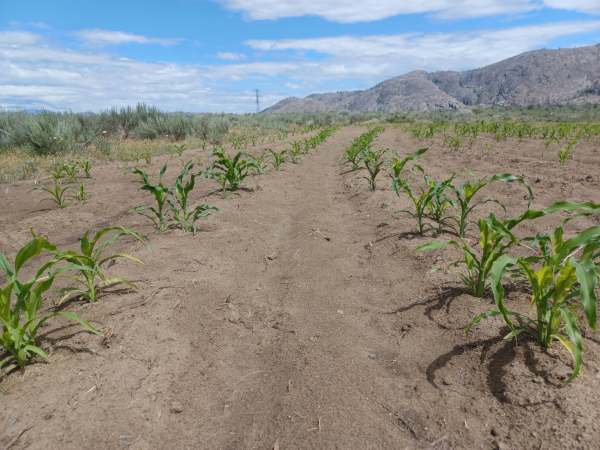
Field 1 / Tractor Tilled
The major difficulty is simply the lack of water and all living things require water. An annual precipitation of less than 12 inches and a well that produces less than ½ a gallon per minute may not seem like much but using drip irrigation it is enough to run 600 ½ gallon per minute drippers (assuming 300 gallons are allocated for gardening). We use 3 drippers or 1½ gallons per day around 20 semi-dwarf fruit trees and grape vines and are able to keep them reasonably healthy and produce fruit (increasing drippers may be needed if the trees or vines get larger). To conserve water it is a good strategy is to plant a few seasonal vegetables around each fruit tree near the drippers.
We rely on a tractor with the aim of growing most of our own food while increasing the water holding capacity, fertility, and productivity of our soil. The plan includes planting of windbreaks, adding fertilizer, contouring or making swales to increase water infiltration, tilling as needed, and planting crops to capture rain & snow, reduce surface evaporation, and increase the nitrogen content & percentage of organic matter of the soil.


Hopi Blue Corn Ears / 2022
|
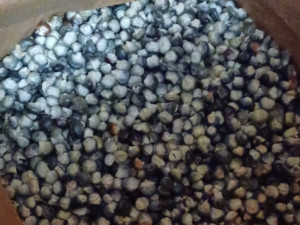

Hopi Blue Corn Shelled / 2022
|
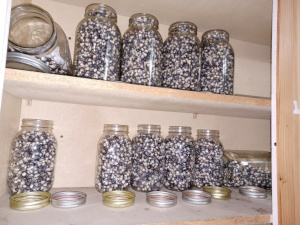
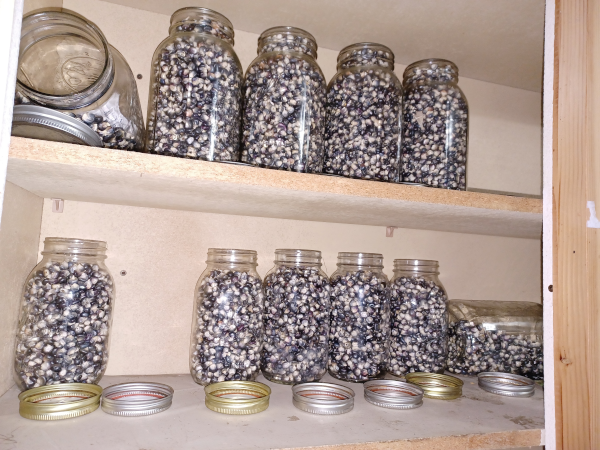
Hopi Blue Corn Seeds / 2022
|
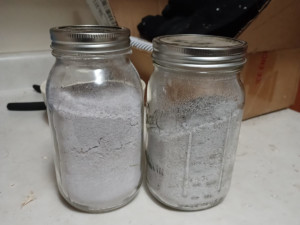

Hopi Blue Corn Flour / 2022
|
Soil quality (topsoil depth) and wind are additional issues. There was a fire on our 20 acres which burnt most of the sagebrush in 2016, there are no trees, and in most places there is a couple feet of loam covering glacial till turning to sand and rock below 12-36 inches. The soil has almost no nutrients and the well water is ph 8.2. Annual rainfall is less than 12 inches with most precipitation being snow in winter months and almost no rainfall from mid June till mid September. Winter temperatures can get down to -13° F with 18mph winds, wind chill factor -32° F with snow usually 1-3 feet deep and drifts up to 10ft deep. Winds of 40mph with gusts up to 75mph occur several times a year. We have planted several species of pines (ponderosa, pinion, austrian) in a 500ft L shape as a wind break that will take many years go grow. Ponderosa pines are notably drought tolerant and once established should not need supplemental irrigation. Some natural ponderosa pines are visible at the same elevation and up the sides of nearby rocky bluffs. Pinion pines are also quite drought tolerant and should eventually yield pine nuts large enough to eat though they they do suffer some setbacks/damage by the cold winters.
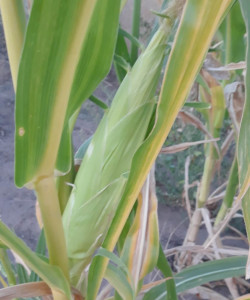
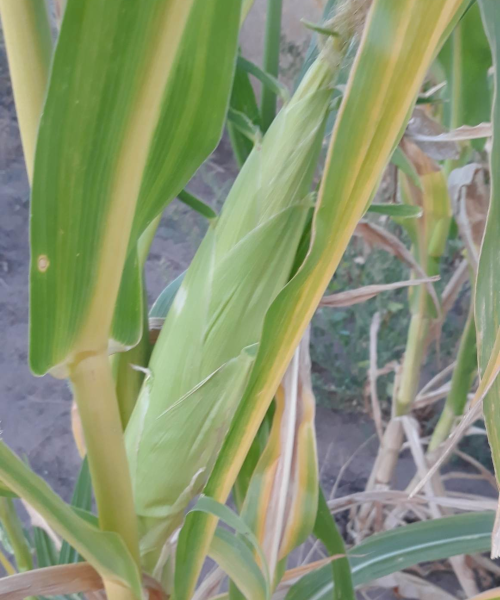
2022 Success - Not Irrigated Corn
After trying different drought tolerant crops for several years we tried Hopi Blue Corn and Ba Ye Qi sorghum in a 40×60 plot. After planting the Hopi Blue Corn we changed the garden layout, tilled deeply, and replanted part of the area with drip irrigation. Surprisingly some of the deeply tilled corn grew in an area without irrigation just as fast as the irrigated corn and produced ears with kernels. Hopi Blue Corn is a soft flour corn that is easy to process and grind, and the raw kernels are easily chewed. Before cooking dry Hopi Blue Corn tastes starchy and very slightly sweet. If harvested at the milk stage Hopi Blue Corn can be cooked and eaten similar to sweet corn.
A Hopi farmer named Akhima, other Hopi farmers and researchers, and a research paper by Collins, G. N. (1914). A Drought-Resisting Adaptation in Seedlings of Hopi Maize. Journal of Agricultural Research Research are good resources on how the Hopi plant and care for their corn fields. Collins tested 3 varieties of corn and found in contrast to the other 2 types he tested the Native American type could successfully grow when planted as deep as 12 inches. This article is worth reading and the pictures at the end are amazing. The plates show corn 3 ft tall with ears making up half the height! Adapted planting styles and local climatic conditions in the Southwest allow these types of corn to grow and produce in hot arid inhospitable climate of northern Arizona. Farmers rely on snowfall to provide water during the early stages of growth and summer monsoons supplement water during tasselling, pollination, and grain fill. Corn is planted in hills 6-20 seeds per hill and after emergence the weaker plants are thinned till there is 4-6 plants per hill. Farmers choose low areas to collect monsoon runoff and protect the crop of wind, and plant in areas adjacent to rabbit-brush which is an indicator of underground water. Some native types of corn can be planted up to 18" deep using soil moisture from snow and spring rains to germinate and the once established the roots can grow to get water stored several feet, possibly up to 8 feet underground.
In the Southwest where Hopi Corn is traditionally grown summer monsoons provide several inches of rain while our location gets almost no precipitation during the summer and we have a shorter growing season. We testing various planting methods in 2023 to see if we can get a reasonable yeild under local conditions. Colorado Bob and E. Ray Gard both have interesting results with Hopi Corn and E. Ray Gard's results on pre-sprouting corn seems useful.
Genetics & Seed Sources
In 2 or 3 generations corn will show results of a lack of selection or selection for undesirable traits. Selective pressure for drought tolerance or deep planting must be maintained or the plants in the population will start to loose these traits. When buying seed it is a good idea to check who, where, how, and under what conditions they were grown. Most seed vendors don't include this information and describe the heirloom 'original' characteristics, planting suggestions, uses, organic status and GMO status, but not the location planted (precipitation), the depth planted, or if they were irrigated. Almost always the quality and germination rate of purchased seed (despite supposed testing) is lower than those of in-house saved seeds. It is best to grow out a smaller test batch and save seeds for larger planting in the second year and in the second year add a 5-10% purchased seeds to maintain population diversity.
Saving Seeds & Genetic Diversity in a Population
Genetic diversity in corn is an important consideration when saving seeds as inbreeding will result in an abundance of progeny with 2 copies of defective or lethal genes. This is called inbreeding depression and occurs when a breeding population is too small. In corn a minimum of 100 parents or 100 ears of corn is recommended for saving seeds for the next generation. Other strategies to avoid inbreeding depression would be to save a few seeds from each year and use a combination seeds from different years for each planting. Also adding 5-10% of new planting material from outside sources (of the same heirloom type of course) each year is sufficient to avoid inbreeding depression. In short save at least 100 of the best ears of corn to plant in the future and do not plant all of those the next year but save some to mix in future years. If fewer seeds are needed save 1/4 of the kernels from each of 100 ears for each variety.
Dryland Hopi Corn Experiment 2023